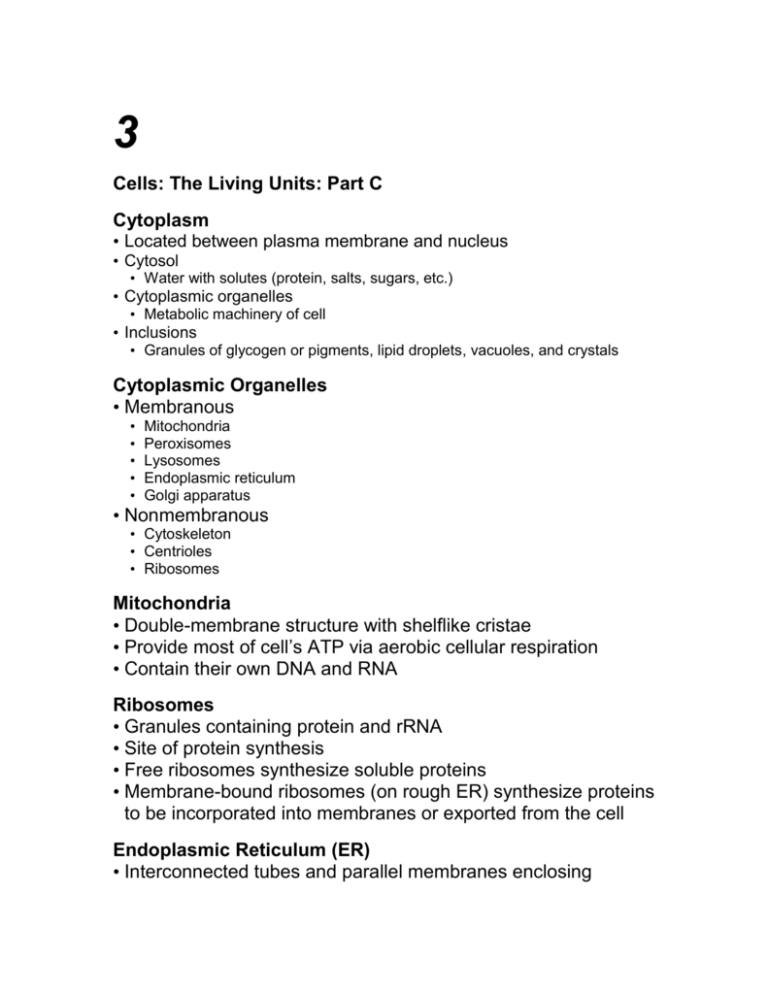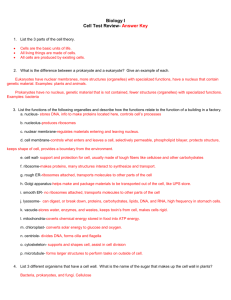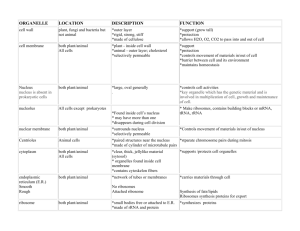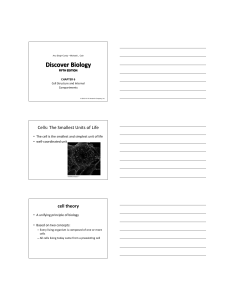Cells: The Living Units: Part C Cytoplasm Cytoplasmic Organelles
advertisement

3 Cells: The Living Units: Part C Cytoplasm • Located between plasma membrane and nucleus • Cytosol • Water with solutes (protein, salts, sugars, etc.) • Cytoplasmic organelles • Metabolic machinery of cell • Inclusions • Granules of glycogen or pigments, lipid droplets, vacuoles, and crystals Cytoplasmic Organelles • Membranous • • • • • Mitochondria Peroxisomes Lysosomes Endoplasmic reticulum Golgi apparatus • Nonmembranous • Cytoskeleton • Centrioles • Ribosomes Mitochondria • Double-membrane structure with shelflike cristae • Provide most of cell’s ATP via aerobic cellular respiration • Contain their own DNA and RNA Ribosomes • Granules containing protein and rRNA • Site of protein synthesis • Free ribosomes synthesize soluble proteins • Membrane-bound ribosomes (on rough ER) synthesize proteins to be incorporated into membranes or exported from the cell Endoplasmic Reticulum (ER) • Interconnected tubes and parallel membranes enclosing cisternae • Continuous with nuclear membrane • Two varieties: • Rough ER • Smooth ER Rough ER • External surface studded with ribosomes • Manufactures all secreted proteins • Synthesizes membrane integral proteins and phospholipids Smooth ER • Tubules arranged in a looping network • Enzyme (integral protein) functions: • In the liver—lipid and cholesterol metabolism, breakdown of glycogen, and, along with kidneys, detoxification of drugs, pesticides, and carcinogens • Synthesis of steroid-based hormones • In intestinal cells—absorption, synthesis, and transport of fats • In skeletal and cardiac muscle—storage and release of calcium Golgi Apparatus • Stacked and flattened membranous sacs • Modifies, concentrates, and packages proteins and lipids • Transport vessels from ER fuse with convex cis face of Golgi apparatus • Proteins then pass through Golgi apparatus to trans face • Secretory vesicles leave trans face of Golgi stack and move to designated parts of cell Lysosomes • Spherical membranous bags containing digestive enzymes (acid hydrolases) • Digest ingested bacteria, viruses, and toxins • Degrade nonfunctional organelles • Break down and release glycogen • Break down bone to release Ca2+ • Destroy cells in injured or nonuseful tissue (autolysis) Endomembrane System • Overall function • Produce, store, and export biological molecules • Degrade potentially harmful substances Endomembrane System Peroxisomes • Membranous sacs containing powerful oxidases and catalases • Detoxify harmful or toxic substances • Neutralize dangerous free radicals (highly reactive chemicals with unpaired electrons) Cytoskeleton • Elaborate series of rods throughout cytosol • Microtubules • Microfilaments • Intermediate filaments Microfilaments • Dynamic actin strands attached to cytoplasmic side of plasma membrane • Involved in cell motility, change in shape, endocytosis and exocytosis Intermediate Filaments • Tough, insoluble ropelike protein fibers • Resist pulling forces on the cell and attach to desmosomes Microtubules • Dynamic hollow tubes • Most radiate from centrosome • Determine overall shape of cell and distribution of organelles Motor Molecules • Protein complexes that function in motility (e.g., movement of organelles and contraction) • Powered by ATP Centrosome • “Cell center” near nucleus • Generates microtubules; organizes mitotic spindle • Contains centrioles: Small tube formed by microtubules Cellular Extensions • Cilia and flagella • • • • Whiplike, motile extensions on surfaces of certain cells Contain microtubules and motor molecules Cilia move substances across cell surfaces Longer flagella propel whole cells (tail of sperm) Cellular Extensions • Microvilli • Fingerlike extensions of plasma membrane • Increase surface area for absorption • Core of actin filaments for stiffening Nucleus • Genetic library with blueprints for nearly all cellular proteins • Responds to signals and dictates kinds and amounts of proteins to be synthesized • Most cells are uninucleate • Red blood cells are anucleate • Skeletal muscle cells, bone destruction cells, and some liver cells are multinucleate Nuclear Envelope • Double-membrane barrier containing pores • Outer layer is continuous with rough ER and bears ribosomes • Inner lining (nuclear lamina) maintains shape of nucleus • Pore complex regulates transport of large molecules into and out of nucleus Nucleoli • Dark-staining spherical bodies within nucleus • Involved in rRNA synthesis and ribosome subunit assembly Chromatin • Threadlike strands of DNA (30%), histone proteins (60%), and RNA (10%) • Arranged in fundamental units called nucleosomes • Condense into barlike bodies called chromosomes when the cell starts to divide









